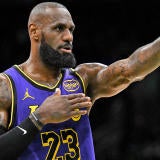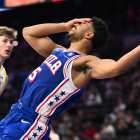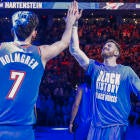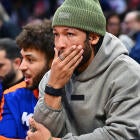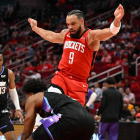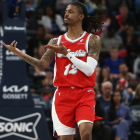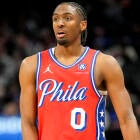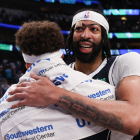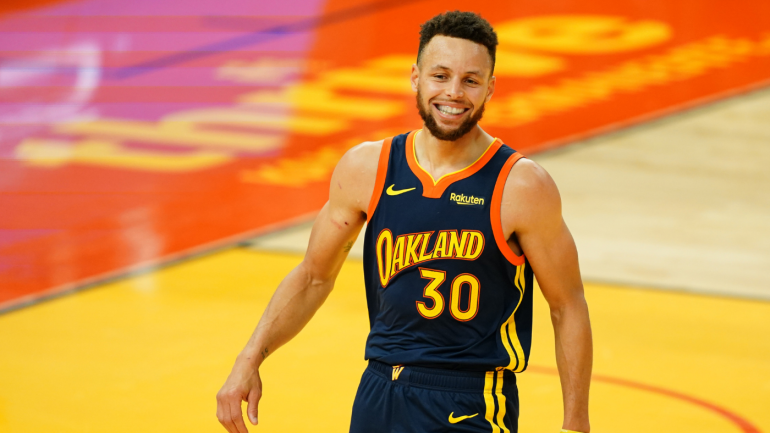
For as far back as I can remember, I have been a bonafide sports hothead. Not so much when I played, when I was actually too easy-going, almost indifferent to winning and losing. It was when I argued that I flew right off the handle and absolutely had to be right.
I grew up in Northern California when the San Francisco 49ers were in their heyday, and I decided early on that I was going to go against my friends and root for John Elway and the Broncos. For years, I held firm in the belief that Elway was not only better than Joe Montana but the best quarterback of all time.
I could support this stance. It went something like this: He was athletically superior, could make throws nobody else could make, and he never played with anywhere near the kind of supporting talent Montana was spoiled with in San Francisco.
Once Elway got his All-Pro teammates like Terrell Davis and Shannon Sharpe, and an offensive-minded coach in Mike Shanahan instead of Dan Reeves (who was stuck in the conservative mud and would only turn Elway loose when the Broncos were on the edge of death, which is why he was forced into making so many fourth-quarter comebacks), he started piling up his own Super Bowl rings.
To say I argued passionately about Elway and the Broncos would be an understatement. I think I might have lost a few friends. I can't imagine if Twitter was around. I would've been lost forever.
Fast forward a couple of decades, and now I cover the NBA for a living. Different sport, same passionate, borderline hothead, tendencies. I respect the people who remain neutral in their analysis. For the most part, I aim to do the same myself. I study this stuff hard. I talk to as many people as I can. I blend input from scouts, coaches, GMs and players (back when that was possible) with my own observations and attempt to paint a fair picture.
But I'll be damned if my gut reactions don't get the better of me sometimes. I will argue it's an informed gut, but it's a gut nonetheless. If I believe something, and if I can support it, I write it. Often in the middle of the night. My every thought doesn't pass through the three stages of FDA approval. Obviously, with the benefit of hindsight, a few of these, shall we say, microwaved takes are going to end up looking pretty dumb.
I'm cool with that. I'm not Ben Simmons. I don't not shoot because I'm afraid to miss. If I toss up a brick, I'll own it. I may argue until I'm blue in the face, but I'll eventually own it.
Which is how we've arrived at this particular article -- one of the hundreds I have written this season. Of those hundreds, two stick out to me as especially stupid. Throw in one of the most idiotic tweets you could ever imagine -- which as a lifelong Warriors fan I will regret for the remainder of my days -- and the way I figure it, I did three specific players and one coach pretty wrong this season. Presented with the necessary context, these are my apologies.
1. Stephen Curry
On Jan. 1, I watched Stephen Curry put up 26 points on 9-of-20 shooting, including 4-of-12 from 3, in a 25-point loss to the Blazers. In that same game, I watched Damian Lillard put up 34 points on 11-of-21 shooting, including 6-of-10 from 3. It wasn't so much that Lillard had a better game as it was how he had a better game. Terry Stotts was putting the ball in his superstar's hands while Steve Kerr, it seemed to me, had been actively taking it away from Curry by almost refusing to allow him to isolate or initiate pick-and-roll with any regularity through the first five games of the season.
This has driven me to pillow-punching levels of frustration for years. Believe me, I understand the merits of utilizing Curry off the ball and the power of an inclusive offense. It has yielded historic team results, even if adding Kevin Durant sucked a lot of the fun out of Curry. But now that Durant was gone (thank the basketball gods) and Klay Thompson was out for the year with a torn Achilles (damn those same gods), I allowed myself to believe that old, appointment-television Curry was about to resurface.
Instead, it was Lillard from whom I couldn't divert my eyes. Dating back to the bubble (and really beyond that), if you missed one of Dame's games, you had to reckon with the risk of missing something you might never see again. Lillard was now the one firing from a million feet away, snatching victory from the jaws of defeat with positively ludicrous shots made to look routine,
I could see the writing on the wall: A season of watching Curry cede possession to supremely inferior players who were individually and collectively ill-equipped to make the kinds of anticipatory reads and instinctive passes required to maximize Curry playing off the ball. And, well, I snapped. In a moment of great haste, I sent the following words into the jagged teeth of NBA Twitter:
Lillard is what Curry used to be
— Brad Botkin (@bradbotkincbs) January 2, 2021
Then I doubled down with this:
I will say this was worded badly. Lillard is not what Curry was in 2015-16. But he is a better player at this moment in time than Curry, and I would bet on it staying that way
— Brad Botkin (@bradbotkincbs) January 2, 2021
On the list of extraordinarily awful sports takes, this has to be right near the top. I can only be thankful this was just a dumb tweet. There are a million of those. Believe me, I wanted to turn this into a full-fledged story, which I would've sunk my soul into supporting because, as I said, when I write something, I believe it. And I absolutely believed this.
The funny thing is, I meant this more as a Dame compliment than a dig on Curry. In fact, it wasn't even really Curry I was taking a shot at. It was Kerr. And I still believe Kerr played the Warriors to 5-7 fewer wins this season by waiting far too long to simply allow Curry to be Curry. This was never about truly thinking that Curry's game had diminished, though I will admit I did allow that thought to enter my mind as I watched him go multiple possessions without touching the ball and, to start, have far less impact on games and certainly possessions than a player of his caliber should ever have.
But in the end, I said what I said. I lobbed it out to the world that Damian Lillard was, and would continue to be, a better basketball player than Stephen Curry, who proceeded to punish Lillard's Blazers -- and me -- with 62 points two nights after I tweeted this and went on to win the scoring title in a season that made morons like me look foolish for ever questioning a living legend. I wish I could take it back. But scrubbing tweets is for bums. All I can do is apologize. So, I'm sorry, Steph. May no stone this ignorant ever be cast upon your great name again.
2. Trae Young
This one is tricky because I'm not apologizing so much for what I said about Young as how I said it. In fact, what I said, technically speaking, turned out to be pretty accurate: He's not a good enough shooter to warrant some of the shots he takes. But the headline, admittedly, was unnecessarily inflammatory, even attacking.

I published this story on Jan. 16. Young and the Hawks, after a sizzling start to the season, were skidding, having dropped six of their previous seven games. Young, at the time, was shooting under 27 percent from 3, and he had been particularly bad in fourth quarters, where the Hawks were operating at a league-worst level.
This was not merely a cold stretch for an otherwise great shooter. In fact, this was a stretch of inconsistency far more representative of Young's shooting than the average fan probably realizes.
Consider: the average NBA shooter makes 36 percent of his 3-pointers; Young has reached that mark just once in his three seasons. He shot 32 percent his rookie year and 34 percent this past season. In between, he shot 36 percent in 2019-20, the same number he put up in his one college season at Oklahoma.
You can argue the difficulty of Young's shots constitute a deceiving on-paper percentage, and that's true to a degree. But Young is choosing to take a lot of those tough shots. In 2019-20, he jacked up 81 shots from 30-34 feet, some three times more than the 26 such shots Stephen Curry attempted in 2015-16, which was the greatest shooting season by the greatest shooter in history. Curry, for the record, made 57 percent of those 30-footers. Young made 33 percent of his.
Young's worst impulses tend to manifest from these super-deep distances and/or early in the shot clock, as was the case with the hoist in question on Jan. 16 -- a 30-foot pull-up with the Hawks trailing by two, 22 seconds to play, and the shot clock turned off.
Again, I'm not exactly going back on what I said about this particular shot or Young's overall shot selection. But I wish I wouldn't have fashioned a headline that depicted a story ignorant to the pains of growth. Players like Young seek and hopefully reach their potential by learning through mistakes, and Young proved himself willing to learn. He trimmed his 3-point attempts per game from 9.5 in 2019-20 to 6.3 this past season. His 30-footers, early clock and tightly contested 3s all went down.
In talking to a lot of people within the Hawks' organization, from president Travis Schlenk and assistant GM Landry Fields to former coach Lloyd Pierce, Atlanta's Trae Young formula -- into which a certain amount of bad shots and pull-your-hair-out decisions were always baked -- became very clear: Turn the guy loose, because in the end the good will outweigh the bad. They were right.
By the end, Young, at 22 years old, had led the Hawks to the conference finals, absolutely cooking two upper-tier defenses in New York and Philadelphia, and had he not gotten injured against Milwaukee I'm not so sure he wouldn't have had Atlanta in the Finals. He did this despite shooting just 31 percent from 3 on nine attempts per game in the playoffs, where he shot 4-for-24 from beyond 25 feet in the first six seconds of the shot clock and missed 22 of his 30 attempts from beyond 30 feet.
Clearly, Young's shooting inconsistencies aren't as big a deal as I made them out to be. Also, I never should've put Curry's name in the headline. Young is more James Harden than Curry in that his shooting, on its own, isn't elite from a statistical standpoint, but it's a core ingredient in an overall sublime offensive package. You start discouraging a player like Young from playing and shooting with absolute freedom, and you might miss out on moments like this:
In Game 7 of the Conference Semis, @TheTraeYoung hit the dagger from deep advancing us to the Eastern Conference Finals.
— Atlanta Hawks (@ATLHawks) August 12, 2021
This Clutch Play in Hawks History is presented by @Clorox. pic.twitter.com/pOC7qaEsU4
That's a dagger, ladies and gentlemen, to beat the No. 1 seed, on the road, in a Game 7. That I ever questioned a guy willing to take, and able to make, that shot, on that stage, at that moment, is ridiculous. All I can say is it won't happen again.
3. Giannis Antetokounmpo and Mike Budenholzer
This one came after Milwaukee's Game 5 loss to the Nets in the Eastern Conference semifinals, and man does it look bad. I had just watched the Bucks blow a 17-point lead to fall behind 3-2 in the series. I was sure it was over. The next day I went on Portland radio and bet Brian Noe a hundred bucks -- no pun intended -- and dinner at a steakhouse of choice that Brooklyn would win the series. I couldn't believe he was betting on the Bucks. On Giannis. On Budenholzer.
About a week later, Brian was eating well.
Meanwhile, the only thing I'm eating is my words.

Imagine writing this about a player and coach who go on to win the whole damn thing less than six weeks later. And I fully believed it. Anyone who knows me at all knows I discriminate, obviously to a fault, against players who can't shoot. I was doing this long before shooting was everyone's favorite skill.
I used to comb through old drafts and shake my head at all the non-shooting perimeter players teams continued to take in the lottery: Elfrid Payton, Emmanuel Mudiay, Kris Dunn, Dante Exum, Michael Carter-Williams, Justise Winslow, Michael Kidd-Gilchrist, Frank Ntilikina, Ricky Rubio, Shabazz Muhammad (who was taken one pick before Giannis in 2013), Stanley Johnson; the list goes on.
Even the non-shooters who were extraordinary athletes in almost every other capacity have hit lower ceilings as lead dogs: John Wall, Russell Westbrook, pre-injury Derrick Rose, Ben Simmons.
I just don't put my money on guys who can't shoot, who, in the half-court, have to get from outside the 3-point line to the rim, which is being guarded by a moat of defenders, to score consistently. In almost every case, it's just not a reliable offense.
And in Giannis, I was just waiting for an opportunity to drive my point home. He was being legitimately stoned by Blake Griffin, who knew right where he was going. He was predictable. Lacking for counter moves. Settling for 3-pointers that he couldn't make (over four per game vs Brooklyn at 22 percent). Bricking free throws, if he hit the rim at all (42 percent for the series).
To be clear, Giannis' numbers against Brooklyn still looked, and were, great. He averaged 32 points and 13 rebounds for the series on 58-percent shooting. When you're as dominant as he is, there's a certain inevitability to your stats. And no, I'm not suggesting Giannis is some kind of all-stats-no-substance guy. I'm simply saying that if and when games get pared down to possessions, he's not the guy you want to be creating your offense.
A kernel of truth remains in this assessment. If Kevin Durant's foot was an inch smaller, his game-tying two-pointer would've been a game-winning 3-pointer and the Bucks, for the second straight season, would've been bounced in the second round. The last thing we would've remembered was the two-time MVP running into yet another wall.
Giannis was again really good against Atlanta, but Jrue Holiday and Khris Middleton took that series for the Bucks, playing visibly freer absent the Giannis log jam in Games 5 and 6 when Giannis was out with a hyperextended knee. Still, those are the guys that have to create most of the half-court offense for Milwaukee. Giannis, in that way, is still not that guy.
But he never should have been expected to be. I suppose that was my first mistake, expecting his game to fit the mold of a typical perimeter-based star in the first place. I would argue that's how he was being deployed. As a ball-handler. A creator. Giannis has always done his damage in the paint, but somewhere along the line in this postseason, he started feeling like an actual interior player.
The doomed-from-the-start possessions that asked him to hit the gas from the top of the key like some sort of crash dummy became fewer and farther between, and when the dust settled he had become an unstoppable postseason force playing his way. He stopped shooting so many 3s and backed his man into the post when isolated. He overpowered everyone on the offensive glass. He hung around for drop-off passes and rolled for lobs.
Antetokounmpo's short-mid-range pull-up jumper is an honest threat, in small doses, against retreating defenders, and he started walking down into shots rather than settling for 3s (he went from taking over four 3s per game vs. Brooklyn to a little over two per game against Atlanta and Phoenix).
Giannis can hit turnaround jumpers from the post, baseline fade-aways, and he started incorporating an acceptable amount of those, making his shoulder turns into the paint slightly less predictable. He started making free throws like a machine -- 17-of-19 in the clinching game against Phoenix.
Instead of a bigger Russell Westbrook (which is admittedly terrifying but still a flawed player), barreling downhill without a jumper as a safety valve, Giannis started playing like a bigger, stronger, faster, more athletic version of prime Charles Barkley -- an athletic train in transition who occupies lower real estate and becomes more power-based in the half-court.
Playing that way, Giannis proved a lot of people, including me, very wrong. His viability as a legit 1A postseason performer was in question -- I would argue deservedly -- and it's not anymore, so long as riding the winds of his strengths rather than pushing against the still real and potentially powerful force of his weaknesses.
As for Budenholzer, I still can't make sense of some of the stuff he did, and has previously done, in the playoffs. He was slow to go small when Brook Lopez was getting roasted. Milwaukee's offense, for long stretches, was just a jumbled compilation of random, contested and self-created jumpers while a hobbled James Harden was just waiting to be attacked. He wouldn't use Giannis to defend Durant, just as he wouldn't use him on Jimmy Butler when the Bucks were eliminated by the Heat in the 2019-20 Bubble postseason. I'll never understand Budenholzer's reluctance to play his best players big minutes.
In the aforementioned Game 5 against Brooklyn, Harden, despite being on basically one leg, played 12 more minutes than Holiday. Durant played all 48, because Steve Nash knew not to overthink it. Budenholzer played with fire, but he got away with it, and before it was over he started making some good adjustments. He played Giannis 91 total minutes over the final two games of the series, including 50 in Game 7.
Meanwhile, he turned Holiday loose defensively in subsequent rounds. He moved his entire defense up a click higher and started having his wing defenders help down harder on pick-and-roll drivers -- namely Trae Young and Chris Paul -- while Lopez split the difference between drop and high coverages.
He played Holiday and Middleton 42 minutes per game in the Finals, and Giannis 40 minutes. In the end, he stuck with his guys and, for the most part, his philosophies, and he won a championship. Nothing more needs to be said. He was smart. I was dumb. Coach Bud did not, as I stated in that article, "coach his way into the unemployment line."
Good grief. What an awful take. Three of them, in fact -- not a bad ratio considering the hundreds of articles I wrote this season, but deserving of a retraction nonetheless. I wish I could say it will never happen again, but knowing myself, there are only two things I can say with virtual certainty: This will happen again, and John Elway is the greatest quarterback to ever live.
![[object Object] Logo](https://sportshub.cbsistatic.com/i/2020/04/22/e9ceb731-8b3f-4c60-98fe-090ab66a2997/screen-shot-2020-04-22-at-11-04-56-am.png)






